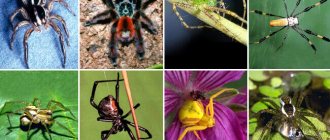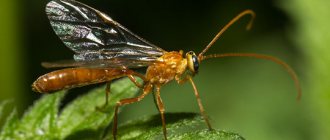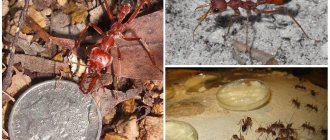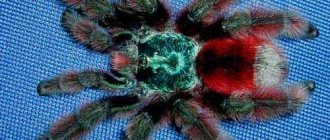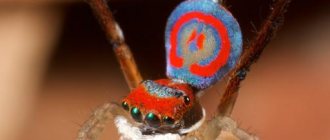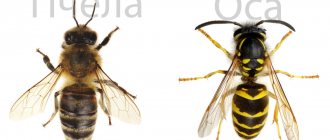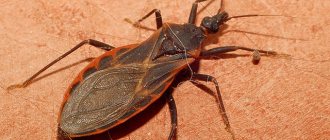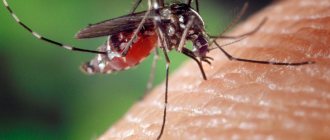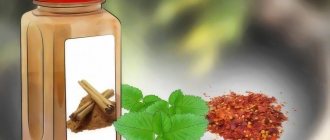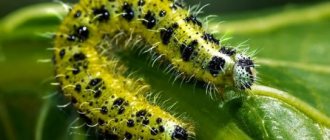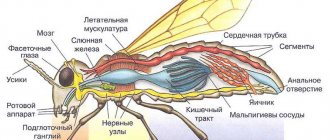Ant: description
The body of an ant consists of 3 main parts, clearly separated from each other - this is the head, which is connected to the chest and abdomen using a thin bridge in the form of a waist. All three parts are covered with a chitinous shell. The eyes of ants consist of a large number of lenses, but they do not allow you to get a good image, but only allow you to react to movement. On top of the head there are 3 additional simple eyes. With the help of 6 thin legs armed with claws at the end, ants are able to move on both horizontal and vertical surfaces. On the ant's head you can see antennae, which serve as organs of touch. With their help, insects detect odors, air fluctuations, and soil vibrations.
Ants mainly live by smell, since by smell they identify their relatives, determine the location of food, give danger signals, etc. Ants can secrete poison or formic acid, which allows them to defend against natural enemies. In addition, ants bite and it hurts very much.
The size of insects depends on the species, as well as on the functions that are intended for all members of the colonies. Therefore, their size ranges from 1 mm to 3 cm. It is characteristic of some species that the size of female individuals is larger than the size of working ants. Females grow wings, which disappear after the fertilization process. Different types of ants also differ in their color patterns. Therefore, there are ants of various colors.
TOP 10 INCREDIBLE FACTS ABOUT ANTS
Regular and supercolonies
Most often, ants are aggressive towards members of other colonies and form simple colonies. However, in some species, workers from different anthills mix. A group of colonies in which ants are not subject to mutual aggression is called a supercolony. Populations of supercolonies are not necessarily located in neighboring territories.
Anthills of red forest ants (Formica rufa) in the Czech Republic
The largest supercolony of associated ant colonies known before 2000 was discovered in the 1970s in Japan near Ishikari Bay on the island of Hokkaido. It is estimated that there are about 306 million worker ants and 1.1 million queen ants. One of its researchers, Professor Seigo Higashi, believes that the age of the colony could be up to 1000 years. A super colony of anthills is in danger of being destroyed due to construction work in the area.
Anthill in section
Types of ants with photos and names
Today, scientists know about 13 thousand species of ants, with about 300 species found within our territories. The species are so similar to each other that it is quite difficult to classify them, especially if a person is not a specialist.
Therefore, it makes sense to pay attention to the most famous and frequently encountered species.
Black garden ant
This species is considered the most common species, since similar ants are found in almost all corners of our planet. Working individuals grow up to 4 and a half mm in length. Males are not significantly characterized. but large in size (up to 5.5 mm), and females have a length from 7 and a half to 11 millimeters. The body of the classic garden ant is covered with short, sparse bristles. They nest deep in the ground, under large stones, and also in unusable (rotten) wood. The main source of food for garden ants is the sweet liquid secreted by aphids. Therefore, ants not only protect aphids, but also breed them on various garden crops, which is why they can cause significant harm to the future harvest. What is interesting: the life expectancy of the queen is about 30 years, which is a record value for this category of insects.
Red myrmica
This type of ant has become widespread both on the European continent and in the Urals, Siberia and the Far East. Females of this species are reddish, up to 6 mm in length, and males are almost black and slightly smaller in size (up to 5 mm). On the body of this species you can also see, albeit sparse, short hairs. They form their nests in the ground, under boulders or under fallen tree trunks.
Small forest ants
They prefer to settle in forests with a temperate climate, distributed throughout the Euro-Asian continent. Ants are distinguished by a red-brown body color, with red cheeks and a black abdomen. They grow in length from 7 to 14 mm. Forest ants form anthills up to 2 meters high in forests. Needles and branches are used as building materials. The species is listed in the Red Books of many countries with endangered species status. Therefore, in some countries, as well as in certain regions, this insect is extremely rare.
Pharaoh ant
Egypt is considered the homeland of this species, but in our time, pharaoh ants have settled in almost all corners of the earth. Working individuals are about 2 mm long and do not have wings. Males are black in color and have wings. They grow up to 3 and a half mm in length. Females also have wings, but only until the moment of mating, after which the males rid them of their wings. They prefer to build nests in dark, moist places. They can be found even in an apartment in a wardrobe or in various household appliances.
Dinoponera gigantea
This species of ants is the largest in the world, since the length of their body is more than 3 cm. The species is distinguished by an almost black color of the body. This species lives in humid environments, in forests common in the Savannah of South America, including the Amazon River basin. This species does not have females, but they are workers who are capable of reproducing. Giant dinosaur ants live in numerous (up to 20-30 individuals) families, the nests of which are formed in the thickness of the earth, at a depth of about half a meter. Males always have wings, so they can fly.
Asian tailor ant
This ant can be found without problems in Australia, Vietnam, Thailand, Bangladesh, as well as in South India in tropical and subtropical climates. This species of ant is distinguished by its bright green color. At the same time, the abdomen is painted in red-orange tones, and the legs are beige. Working individuals are up to 8 mm in length, with males growing up to almost 1 cm in length, and females up to 1.3 cm in length. They prefer to live in trees in colonies of 500 thousand individuals, or even more. Therefore, a colony can occupy several trees at once. They build their nests from leaves, which are connected to each other using the characteristic sticky secretions of the larvae. That's why they were called "tailors".
The population of these places uses the larvae and pupae of these ants as food for poultry, as well as in traditional and folk medicine, including in the national cuisine of some Asian countries.
Eastern Liometopum
It is considered a species that is in danger of extinction, since it is listed in the Red Book, while it is an inhabitant of the Far East. Working individuals are dark brown in color and measure about 6 mm in length. Males and females are almost black and grow to 10 and 12 mm in length respectively. They build their nests in Korean pine, fir, Mongolian oak, linden, birch, etc.
Blood red ant
It is found on almost the entire Eurasian continent, with a preference for the middle zone. Working individuals have an almost black body and a brown head, growing up to 8 mm in length. The uterus is somewhat larger (up to 10 mm), red head and orange chest. Ants make their nests in tree stumps, in the ground, under various objects. With the arrival of winter, they begin to move to nests located at the base of trees. The behavior of this species is that ants raid colonies of other species and capture pupae. After that, they keep them in their nest as “slaves”.
Amazon Ant
Females of this species grow up to 1 cm in length, while males are 2 times smaller, and their “soldiers” are even smaller. The color of females and “soldiers” is yellow-red, and there are black hairs on their body. Males of this species are black in color, with brown antennae and limbs. This type of ant is common in the European part of the continent in western Asia and western Siberia. The species prefers to settle in forests, giving preference to damp areas, near clearings and forest edges. The Amazon ant also practices raids on colonies of other ants and takes pupae with them, after which it keeps them as labor.
Nomadic ants or legionnaire ants
This ant species is a subfamily of nomadic ants, which is common in tropical climates. Entire colonies of these dangerous insects are found in Central and South America, as well as within the African continent. They live in numerous colonies, consisting mainly of working individuals. Despite their relatively small size (no more than 4 mm), colonies of these insects are capable of destroying everything in their path. At the same time, they cause enormous damage to farmland.
Kinds
The simplest anthills are a pile of earth, sand, leaves or clay, or a mixture of these and other materials, piled at the entrances to these underground dwellings during the construction of tunnels. The structure is erected and maintained by many worker ants, who carry small pieces of these materials in their mandibles and leave them near the exits.
Many species of ants build complex anthills, but others lead a nomadic lifestyle and do not erect permanent structures. Ants not only build underground colonies, they can build anthills on trees. Nests can be found underground, rocks, fallen logs, inside logs, inside hollow plant stems, and even in acorns.
Anthill on a tree
Nomadic ants from South America and wandering ants from Africa (genus Dorylus) do not make permanent anthills, but alternate nomadism with stages in which workers form a temporary anthill, creating a structure from their own bodies (holding onto each other) to protect the queen and larvae, which later unravel as they continue their journey.
Dorylus ants attack a locust (for some reason Wikipedia says it is a grasshopper)
Working individuals of tailor ants (also known as weaver ants, or ecophylla) build nests in trees by connecting leaves; workers first hold them down, serving as “bridges,” and then force the larvae to produce silk by moving them along the edge of the leaf. Similar construction methods have been observed in some Polyrhachis species.
Ants carefully choose a place to build a colony; Temnothorax albipennis avoids areas with dead ants, as this may indicate the presence of parasites or disease. They quickly leave already established colonies at the first sign of danger.
The main flood defense system used by ants is a mound of earth at the entrances to the anthill, and after a catastrophic flood, the ants repair the damaged parts of the anthill or, if this is not possible, open new tunnels to the outside.
Anthill Iridomyrmex purpureus in Australia
Natural habitats of ants
If we take into account all types of ants, and there are more than a thousand of them, then they are found on almost all continents and in all climatic zones. Therefore, they are found both in deserts and in the Arctic and Antarctic conditions. In cold climates, ants hibernate in winter.
Their nests can be seen in rotten wood, in the soil, and also under various objects lying on the ground. Some species do not build nests for themselves, but prefer to take over others. Many species prefer to live near humans.
What is it built from?
Most people imagine an anthill as a pile of garbage collected from everywhere. Yes, indeed, in forests, ants mainly build their houses from pine needles, pieces of bark, leaves and other available materials. All of them are laid out amazingly carefully - not every engineer can cope with such a task flawlessly. After all, pine needles, straw and other small building materials are laid in such a way that during even the heaviest rainfall, only the top layer gets wet - no more than 2-3 centimeters. Most of the water gently rolls over the surface of the anthill, without causing problems to the inhabitants.
However, in some cases they prefer to occupy a ready-made rotten stump. Of course, this is only the top part of the anthill itself. There are only a few important rooms located here, most of them are hidden deep underground - we’ll talk about this a little later. This is not at all accidental - in cold climates the earth warms up quite slowly, and ants, like any insects, are highly dependent on the ambient temperature. But the sun’s rays warm up the above-ground part much faster, providing comfort and high productivity to the inhabitants.
But sometimes an anthill from the outside looks just like a small hole in the ground. Most often these can be seen in the steppe or desert. This is not an accident - even if the soil freezes here, it warms up very quickly - spring in such places is usually early, and summer is very hot. Therefore, it is more important for ants not to quickly warm up their home, but to get rid of excess heat. Scientists have found anthills in deserts that go 10 meters deep! There is moisture necessary for life, and the sand never warms up too much.
Diet of ants
Each species of these insects feeds differently, so it is almost impossible to single out specific food. The fact is that they consume food items of both plant and animal origin. However, they can eat quite often.
For normal growth and development of ant larvae, protein is required, the source of which is dead insects, as well as the remains of other animals, trophic eggs laid by the queen, eggs of various harmful insects, as well as semi-digested food of adults.
House ants use dairy products, gelatin, and leftover egg dishes as a source of protein food. The queen ant also consumes protein food, which she receives from the individuals caring for her.
Ants obtain carbohydrates from honeydew, as well as from the liquid secreted by aphids.
Ants are unique living creatures that form entire farms from aphids, after which they “graze” them and protect them from attacks by other ants. As a result, the ants provide their own food.
In addition, ants in nature try to feed on plant seeds, nuts, and green juices. Some species breed entire colonies of mushrooms in their nests, while also feeding on caterpillars and insects.
Harvester ants feed on dry plant seeds, dry fruits, and grain crops. They store up to 1 kg of nutritious material for the winter, which is enough for the entire colony.
Leaf-cutter ants stock up on pieces of leaves, after which they chew them and store them in this form in special chambers. After some time, mushrooms appear on the chewed pieces, which represent the main food source for this family. Centromyrmex ants eat termites exclusively. Dracula ants feed on substances that their larvae secrete, and the larvae eat various insects. We can safely say that these ants are gourmets, which cannot be said about domestic ants, which are omnivores.
When there is a significant cold snap, the ants hibernate, so they do not feed during this period. Some of the species continue to lead an active lifestyle, surviving on the created reserves.
Caste division
Most of the colony consists of worker ants. Half of them provide coziness and comfortable living inside the building, the other takes care of food supplies and is engaged in external construction of the house. The hierarchy is headed by the female, who is more often called the queen or queen. It is she who, having been fertilized at a young age, produces offspring throughout her life and finds a place for an anthill.
After two weeks, ants appear, usually a worker clan. It is they who begin the construction. A small part of the colony consists of young males. Their fate is unenviable - after the female is fertilized, they die within two weeks.
Ant Reproduction
Ants reproduce 2 times a year, and 2 methods are available for them.
The first method is based on the fact that the young female takes with her a certain number of workers and leaves her family to form a new family. As a result of the second method, the female goes on a mating flight, where she is fertilized by males from another anthill. After fertilization, the female lays eggs, after which, after they mature, she has a group of working individuals. The males die after some time. Until the workers mature, the queen feeds on the remains of the muscles of her wings. Females and workers are born from fertilized eggs, and males from unfertilized eggs.
Ants are considered harmless insects until they come into the sight of a person in the home. Although even in a home they cannot cause harm, except perhaps by their movements in search of food. Therefore, they should not be exterminated, since they destroy many harmful insects.
Structure
- The entrances are guarded by soldier ants. They recognize the inhabitants of their anthill by smell and do not allow “foreigners” into it.
- The task of foraging ants is to obtain food. Along the way, they emit a smell and then return to the anthill (ants have very poor eyesight).
- Young ants take care of the eggs. They constantly lick them and cover them with saliva to prevent them from becoming moldy.
- The queen lays eggs all day long. Young ants bring her food.
- Cleaner ants remove waste from the anthill.
All articles
How does an anthill work?
Ants are social insects and their life activity is somewhat reminiscent of human life, where society consists of people of various professions.
Their home (anthill) has a unique structure, which only the mind can do. For example:
- Ants are engineers and builders who form their nest through tunnels and other communications.
- In the society of ants, there are soldiers who protect the anthill from attacks by natural enemies, and also help to capture other territories.
- Doctor ants monitor the health of working individuals and also perform operations, relieving individuals of injured legs.
- Nurse ants control the development of larvae.
- Foraging ants are busy collecting and storing food, distributing it into special storage areas.
- Farmer ants are busy breeding aphids, cicadas, copperheads and scale insects. They look after them and also “milk” them, obtaining a tasty liquid.
- Leaf-cutter ants are busy collecting and identifying leaves, after which colonies of fungi grow from them. There are also ants - fungal growers, who use both insects and feces to grow mushrooms.
- Harvester ants are busy collecting seeds from various plants.
- Carpenter ants are busy collecting juices secreted by various plants.
- Gravedigger ants practice moving their deceased relatives to a place that can be called a cemetery.
- These are not all professions that allow an ant colony to survive in natural conditions.
Stages of building an anthill
The construction of an ant house begins with the appearance of the sexually mature generation. Under favorable conditions, the queen (queen) lays ant eggs. Subsequently, the workers take care of them. Sexually mature females and males leave their anthill to build a new colony and reproduce.
It is interesting to watch how ants build an anthill. First, they find and carefully examine a site for a new home. It is important for them that there are no dead ants in the selected area; it is advisable that there be “hunted” prey there (a large caterpillar, a frog, a beetle, a pile of sugar, seeds and mushrooms). The place should be in the shade, have normal humidity and ventilation.
Ants build a common house from various blades of grass, leaves, earth, and bark. The building material is carefully crushed and glued together with ant glue. The work is carried out very carefully and thoroughly, for centuries. Construction continues around the clock as the ant colony grows rapidly. Almost all their lives, these hard workers build their home, increasing it both in depth and height.
Interesting facts about ants
- The bullet ant, which lives in tropical conditions, can bite by injecting a fairly potent poison that causes pain in the victim, which is several times greater than the sensation of a bee or wasp sting. Indian tribes who know this teach their younger generation to be resistant to severe pain. To do this, they place the boy's hand in a plastic bag with these insects. As a result of numerous bites of these insects, the hand begins to swell, and the person feels incredible pain.
- Ant eggs are nothing more than larvae, and some tribes in Africa and residents of other Asian countries have no problem including them in their diet. Many believe that larvae contain a lot of protein, and plus, eating them increases potency. Mexicans generally spread these eggs on corn tortillas and eat them with pleasure on holidays, like many nationalities eat red caviar.
- The queen, on which the life of the colony depends, can live for about 6 years. Moreover, there is evidence that the queen was able to live for as long as 14 years, which is an absolute record for the insect order.
Rhymes and videos for kindergarten and primary school children
Surely, there is at least one anthill on the territory of the kindergarten. And teachers ask children not to trample on it. There are two reasons for this. Firstly, I feel sorry for the insects who work all their lives to keep the house in order. Secondly, being bitten by ants is a bad thing for kindergarten children. To make kids more conscious of the small life around them, educators should show them an educational video about how an anthill works and what happens in it.
Short poems for kindergarten and primary school
The story about the dragonfly, which devoted the whole summer to entertainment, completely forgetting about preparations for winter, and then went to seek shelter with an ant, is known to us exactly in the form in which I.A. presented it to us. Krylov. But he is not the author of the idea. Previously, the topic was touched upon by other fabulists - La Fontaine and Aesop.
This short poem, understandable to the smallest children, is also dedicated to the hard work of the insect.
Children's video
Fable by I.A. Krylov was dressed as a cartoon several times. This option is perhaps one of the most successful.
Hardworking people, forest healers, forest friends - this is what ants are called. In this educational video, kids are invited to visit them.
Perhaps every person has seen an anthill. However, not everyone realizes how complex the structure of an anthill is - it is much more complex than any skyscraper created by people. Hundreds of thousands, and sometimes millions of developed insects work here day and night, each of them busy with their own business.
What do ants do
Very few people who are not seriously interested in this issue have any idea how an anthill works. But this is truly a complex society.
You may be interested in: Mixture of tocopherols: description, chemical properties, application, benefits and harm
To begin with, it is worth noting that all ants are divided into three groups: the queen (aka the queen, the only one in the anthill), males (up to several dozen, needed to fertilize the queen) and workers. It is the latter that is worth talking about in more detail.
Some experts identify up to ten specialties that include working ants. Moreover, each of them is engaged in his own business from birth to death, and has a certain structure for this. For example, soldier ants have a particularly large head - if necessary, they can block a passage with it, preventing the enemy from entering a long corridor. Nurse ants are distinguished by very delicate antennae, which allow them to detect the slightest movements in the pupae and eggs. The midwives who directly care for the queen are very similar to them. They feed her, remove waste products, stroke her, helping her lay new eggs (several thousand a day). Loader ants have powerful necks and legs, thanks to which they lift enormous loads for their bodies. Builders have glands that produce sticky saliva that is used to hold building materials together.
And this is not counting the highly specialized ants that are found in specific anthills, depending on the direction of their economy.
Ants - what kind of insects?
Ants are, first and foremost, social insects, even more so. An anthill is not just a collection of individuals, but an entire civilization with its own history of development and adaptation to the surrounding world, social roles and harmony. They live in communities. Lonely individuals, straying from their colony, soon die.
These insects are difficult to classify, since there are a huge number of twin species and hybrids. Therefore, scientists came to the conclusion that they should be classified according to types and behavior:
- ants that build shelters (this includes forest, meadow, and those that build nests on the street);
- house ants;
- carpenter ants;
- fire ants (dangerous, poisonous).
Currently, more than 13,000 species of ants have been recorded.
What is the role of ants in nature?
The role of ants in nature was determined long before people paid attention to these nimble, hardworking insects. In nature, ants:
- loosen the soil, thereby filling it with oxygen;
- maintain the soil water regime balanced;
- maintain a stable level of soil acidity;
- accelerate the process of decomposition of organic matter;
- fertilize the soil with humus;
- destroy leaf-eating pests;
- contribute to the suppression of mass reproduction of any other species of insects;
- transfer seeds of flowers and plants, promoting their reproduction;
- Forest animals use anthills as “medicinal baths” to get rid of parasites that bother them.
When ants settle in garden plots or in houses, the harm from their activities clearly outweighs the benefits.
How to draw Ants with a pencil step by step
Step 1. Firstly, before you want to draw an ant, it might be helpful if you know something about its anatomy. The first four pages will be about ant anatomy to start with.
Step 2. After his outfit, you can now see his inside anatomy. Now the most important thing is that when you draw them, just for fun.
Step 3. Here you can see his head anatomy, you can see the details. Well, it doesn't matter if you draw them as small in your picture, but if you want to attract them in a larger size, it can be useful.
Step 4. And now, here's a fly in top view so you can see some of the details well.
Step 5. First, here are some tips for the ant head drawing. Some of them are cute, some of them are really scary in larger sizes. Now, your choice is what, what would you like to draw.
Step 6. And now, just your choice, then what exactly you would like to draw, here are some tips and type of ant drawing. Can you believe how many shapes they got?
Step 7. As the ants live in the colony there are some differences in their bodies, they are not similar to each other. It depends on their caste in the colony.
Step 8. And here are the extra pages, about the ant's life, you can clearly see where they begin, how they envolve in their lives.
Step 9. And now, the last extra pages, here they go home, to the anthill. You can see in the picture where the parts of the hill are. It may not be important, but if you want to make a difference in your life, it can be really useful too.
Step 10. Let's start the "How to Draw an Ant" part! Now start drawing the base line. It is useful that you can draw the basic shape of the body.
Step 11. For the first part, draw the basic shape of the head!
Step 12. They have little eyes on their heads, draw the basic shape of them.
Step 13. As the next step, draw your little "mouth" on the picture and finish with some small online head too.
Step 14. Draw the basic shape of the antenna.
Step 15. Finishing the small lines and antenna details, this is the last step in Ant head drawing.
Step 16. Next big step, draw the basic "chest" shape.
Step 17. Some lines can be drawn for some details for the chest part and this will be the finishing part in this part of the drawing.
Step 18. Now draw the next larger part, on the “belly” of the base shape.
Step 19. With some small or larger details, you can finish the adbomen part of his body.
Step 20. And now, here we are, on the legs. These seem difficult to draw, but you don't have to draw them well unless you want to be in perfect ant anatomy
Step 21. And now for finishing the leg parts, draw lines that separate the legs from each other parts. These are just some small details and you don't need to draw if you want to draw a simpler ant.
Step 22. For the last part of the drawing - this is not important, just for fun - here are some details for the environment, now your ant can enjoy his little life!
Step 23. Well done!!! Now go ahead and color it however you want. I really enjoy drawing this tutorial, I hope you enjoy it too. Great job guys!
mydrawing.net
Main device
Now let's move on to how the anthill works. The most noticeable layer is the protective one. A thick layer of pine needles, straw or pieces of leaves that absorbs some of the moisture, removing most of it outside the home. At the same time, it acts as a thermal cushion, protecting against excessive overheating and hypothermia. Directly below it is a kind of bathhouse - ants gather here in the spring and early in the morning to warm up, restore functionality and begin their daily work.
There are outputs - from several to a couple of dozen. In the desert or steppe, the distance between them can reach 2-5 meters. In an ordinary forest anthill, the exits are located much more compactly. They lead to common corridors connecting many chambers: food storage, queen housing, a nursery for storing larvae and eggs, a cemetery, which includes dead ants, as well as waste products. Many of them are duplicated (except for the queen’s home, there is always only one per anthill). But there may be several food warehouses, cemeteries, and nurseries. This makes perfect sense for several reasons. Firstly, to make it easier to choose the right one - the one that is closer. Secondly, in case one is damaged, there will be several spares.
Now that you know how an anthill works, it is worth giving a description of individual ants. Then every reader was able to appreciate the complexity of this society.
Amazing Unity
Having become familiar with the structure of the anthill and the description of its inhabitants, the reader will be interested to learn about their unity. The entire population acts as a single organism (this is already known to many).
But as additional information, it is worth giving a clear example. Experts have seen more than once how ants fight fires that have engulfed their homes. They simply put out the fire using formic acid secreted by the worker ants. Each is capable of releasing only a meager fraction of a milligram - fire cannot handle such a blow. However, when tens and hundreds of thousands of individuals come into play at the same time, a small flame cannot resist - it really gets knocked down, goes out, without causing damage to the anthill that it could not survive.
How to draw an ant | How to draw?
Ant
Brief description of the lesson:
This lesson contains step-by-step instructions on how to draw an ant with a pencil.
Watch the online lesson “How to draw an ant”:
STEP 1. Let's draw two circles, one on top of the other. Moreover, the size of the upper circle should be several times larger than the lower one.
Let's draw an ant. Step 1
STEP 2. Draw the outline of the ant's head and two antennae on top of it.
Let's draw an ant. Step 2
STEP 3. Now we need to draw all the details of the head such as the eyes, mouth and nose.
Let's draw an ant. Step 3
STEP 4. Now let's draw the body, which in its shape resembles the body of a bee.
Let's draw an ant. Step 4
STEP 5. In this step we will draw all the legs of our ant.
Let's draw an ant. Step 5
STEP 6. We take an eraser in our hands and erase all the unnecessary strokes from our drawing.
Let's draw an ant. Step 6
Now we know how to draw an ant!
How to see everything with your own eyes?
Many parents, having noticed their children’s interest in ants, wonder how to demonstrate the structure of an anthill to their children. Of course, you can watch various programs, but this is not the same at all.
Fortunately, special ant farms, or formicaria, can now be easily found on sale. They can be made from various materials. It is enough to plant the found queen here and from time to time feed it with insects, sugar syrup or other suitable products. In a few months you will become the owner of your own anthill. Transparent walls make it possible to see everything that happens inside. It is very interesting to follow him for both children and adults. A common interest will certainly bring your family closer together and allow you to find a new topic for communication.
